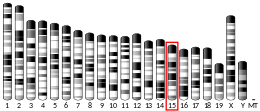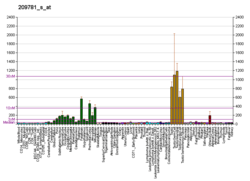KHDRBS3
KH domain-containing, RNA-binding, signal transduction-associated protein 3 is a protein that in humans is encoded by the KHDRBS3 gene.[5][6][7]
| KHDRBS3 | |||||||||||||||||||||||||
|---|---|---|---|---|---|---|---|---|---|---|---|---|---|---|---|---|---|---|---|---|---|---|---|---|---|
| |||||||||||||||||||||||||
| Identifiers | |||||||||||||||||||||||||
| Aliases | KHDRBS3, Etle, SALP, SLM-2, SLM2, T-STAR, TSTAR, etoile, KH domain containing, RNA binding, signal transduction associated 3, KH RNA binding domain containing, signal transduction associated 3 | ||||||||||||||||||||||||
| External IDs | OMIM: 610421 MGI: 1313312 HomoloGene: 4780 GeneCards: KHDRBS3 | ||||||||||||||||||||||||
| |||||||||||||||||||||||||
| |||||||||||||||||||||||||
| |||||||||||||||||||||||||
| |||||||||||||||||||||||||
| Orthologs | |||||||||||||||||||||||||
| Species | Human | Mouse | |||||||||||||||||||||||
| Entrez | |||||||||||||||||||||||||
| Ensembl | |||||||||||||||||||||||||
| UniProt | |||||||||||||||||||||||||
| RefSeq (mRNA) | |||||||||||||||||||||||||
| RefSeq (protein) | |||||||||||||||||||||||||
| Location (UCSC) | Chr 8: 135.46 – 135.66 Mb | Chr 15: 68.93 – 69.1 Mb | |||||||||||||||||||||||
| PubMed search | [3] | [4] | |||||||||||||||||||||||
| Wikidata | |||||||||||||||||||||||||
| |||||||||||||||||||||||||
Interactions
KHDRBS3 has been shown to interact with SIAH1.[8][9]
KHDRBS3 interacts with splicing protein Sam68 and oncogene metadherin in prostate cancer cells.[10]
Clinical significance
KHDRBS3 (T-STAR) expression has been shown to be increased in prostate cancer tissue compared to the surrounding benign tissue.[10] Expression of KHDRBS3 correlates with mpMRI signal measured through Likert score a system similar to PI-RADS.[10] While still under debate, mpMRI signal correlates with higher Gleason grade and tumour size, in addition to histopathological features associated with clinically aggressive prostate cancer.[11][12]
In prostate cancer cell lines KHDRBS3 appears to be androgen regulated, with a reduction in mRNA expression occurring following addition of synthetic androgen R1881 to cells.[10]
References
- GRCh38: Ensembl release 89: ENSG00000131773 - Ensembl, May 2017
- GRCm38: Ensembl release 89: ENSMUSG00000022332 - Ensembl, May 2017
- "Human PubMed Reference:". National Center for Biotechnology Information, U.S. National Library of Medicine.
- "Mouse PubMed Reference:". National Center for Biotechnology Information, U.S. National Library of Medicine.
- Venables JP, Vernet C, Chew SL, Elliott DJ, Cowmeadow RB, Wu J, et al. (June 1999). "T-STAR/ETOILE: a novel relative of SAM68 that interacts with an RNA-binding protein implicated in spermatogenesis". Human Molecular Genetics. 8 (6): 959–69. doi:10.1093/hmg/8.6.959. PMID 10332027.
- Lee J, Burr JG (November 1999). "Salpalpha and Salpbeta, growth-arresting homologs of Sam68". Gene. 240 (1): 133–47. doi:10.1016/S0378-1119(99)00421-7. PMID 10564820.
- "Entrez Gene: KHDRBS3 KH domain containing, RNA binding, signal transduction associated 3".
- Rual JF, Venkatesan K, Hao T, Hirozane-Kishikawa T, Dricot A, Li N, et al. (October 2005). "Towards a proteome-scale map of the human protein-protein interaction network". Nature. 437 (7062): 1173–8. Bibcode:2005Natur.437.1173R. doi:10.1038/nature04209. PMID 16189514. S2CID 4427026.
- Venables JP, Dalgliesh C, Paronetto MP, Skitt L, Thornton JK, Saunders PT, et al. (July 2004). "SIAH1 targets the alternative splicing factor T-STAR for degradation by the proteasome". Human Molecular Genetics. 13 (14): 1525–34. doi:10.1093/hmg/ddh165. PMID 15163637.
- Luxton HJ, Simpson BS, Mills IG, Brindle NR, Ahmed Z, Stavrinides V, et al. (August 2019). "The Oncogene Metadherin Interacts with the Known Splicing Proteins YTHDC1, Sam68 and T-STAR and Plays a Novel Role in Alternative mRNA Splicing". Cancers. 11 (9): 1233. doi:10.3390/cancers11091233. PMC 6770463. PMID 31450747.
- Norris JM, Carmona Echeverria LM, Bott SR, Brown LC, Burns-Cox N, Dudderidge T, et al. (May 2020). "What Type of Prostate Cancer Is Systematically Overlooked by Multiparametric Magnetic Resonance Imaging? An Analysis from the PROMIS Cohort". European Urology. doi:10.1016/j.eururo.2020.04.029. PMID 32370911.
- Norris JM, Carmona Echeverria LM, Simpson BS, Allen C, Ball R, Freeman A, et al. (April 2020). "Prostate cancer visibility on multiparametric magnetic resonance imaging: high Gleason grade and increased tumour volume are not the only important histopathological features". BJU International. doi:10.1111/bju.15085. PMID 32319152.
Further reading
- Di Fruscio M, Chen T, Richard S (March 1999). "Characterization of Sam68-like mammalian proteins SLM-1 and SLM-2: SLM-1 is a Src substrate during mitosis". Proceedings of the National Academy of Sciences of the United States of America. 96 (6): 2710–5. Bibcode:1999PNAS...96.2710D. doi:10.1073/pnas.96.6.2710. PMC 15834. PMID 10077576.
- Venables JP, Elliott DJ, Makarova OV, Makarov EM, Cooke HJ, Eperon IC (March 2000). "RBMY, a probable human spermatogenesis factor, and other hnRNP G proteins interact with Tra2beta and affect splicing". Human Molecular Genetics. 9 (5): 685–94. doi:10.1093/hmg/9.5.685. PMID 10749975.
- Stoss O, Olbrich M, Hartmann AM, Konig H, Memmott J, Andreadis A, Stamm S (March 2001). "The STAR/GSG family protein rSLM-2 regulates the selection of alternative splice sites". The Journal of Biological Chemistry. 276 (12): 8665–73. doi:10.1074/jbc.M006851200. PMID 11118435.
- Sugimoto Y, Morita R, Amano K, Shah PU, Pascual-Castroviejo I, Khan S, et al. (August 2001). "T-STAR gene: fine mapping in the candidate region for childhood absence epilepsy on 8q24 and mutational analysis in patients". Epilepsy Research. 46 (2): 139–44. doi:10.1016/S0920-1211(01)00274-1. PMID 11463515. S2CID 28713407.
- Kool J, van Zaane W, van der Eb AJ, Terleth C (November 2001). "Down-regulation of T-STAR, a growth inhibitory protein, after SV40-mediated immortalization". Cell Growth & Differentiation. 12 (11): 535–41. PMID 11714634.
- Reddy TR, Suhasini M, Xu W, Yeh LY, Yang JP, Wu J, et al. (February 2002). "A role for KH domain proteins (Sam68-like mammalian proteins and quaking proteins) in the post-transcriptional regulation of HIV replication". The Journal of Biological Chemistry. 277 (8): 5778–84. doi:10.1074/jbc.M106836200. PMID 11741900.
- Côté J, Boisvert FM, Boulanger MC, Bedford MT, Richard S (January 2003). "Sam68 RNA binding protein is an in vivo substrate for protein arginine N-methyltransferase 1". Molecular Biology of the Cell. 14 (1): 274–87. doi:10.1091/mbc.E02-08-0484. PMC 140244. PMID 12529443.
- Venables JP, Dalgliesh C, Paronetto MP, Skitt L, Thornton JK, Saunders PT, et al. (July 2004). "SIAH1 targets the alternative splicing factor T-STAR for degradation by the proteasome". Human Molecular Genetics. 13 (14): 1525–34. doi:10.1093/hmg/ddh165. PMID 15163637.
- Cohen CD, Doran PP, Blattner SM, Merkle M, Wang GQ, Schmid H, et al. (July 2005). "Sam68-like mammalian protein 2, identified by digital differential display as expressed by podocytes, is induced in proteinuria and involved in splice site selection of vascular endothelial growth factor". Journal of the American Society of Nephrology. 16 (7): 1958–65. doi:10.1681/ASN.2005020204. PMID 15901763.
- Rual JF, Venkatesan K, Hao T, Hirozane-Kishikawa T, Dricot A, Li N, et al. (October 2005). "Towards a proteome-scale map of the human protein-protein interaction network". Nature. 437 (7062): 1173–8. Bibcode:2005Natur.437.1173R. doi:10.1038/nature04209. PMID 16189514. S2CID 4427026.
- Zhang L, Guo L, Peng Y, Chen B (July 2006). "Expression of T-STAR gene is associated with regulation of telomerase activity in human colon cancer cell line HCT-116". World Journal of Gastroenterology. 12 (25): 4056–60. doi:10.3748/wjg.v12.i25.4056. PMC 4087721. PMID 16810759.
- Olsen JV, Blagoev B, Gnad F, Macek B, Kumar C, Mortensen P, Mann M (November 2006). "Global, in vivo, and site-specific phosphorylation dynamics in signaling networks". Cell. 127 (3): 635–48. doi:10.1016/j.cell.2006.09.026. PMID 17081983. S2CID 7827573.




